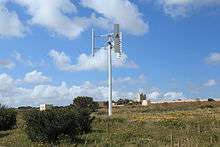Energy in Malta


Energy in Malta describes energy production, consumption and import in Malta.
Malta has no domestic resource of fossil fuels and no gas distribution network. Gross consumption has increased by 53% in 1990-2004. In 2008 the renewable energy market was at an early stage in Malta. Only solar energy and biofuels were used. The potential for solar and wind is substantial according to the EU.[1] Energy import dependency was 100% in 2004.[2]
Overview
| Energy in Malta[3] | ||||||
|---|---|---|---|---|---|---|
| Capita | Prim. energy | Production | Import | Electricity | CO2-emission | |
| Million | TWh | TWh | TWh | TWh | Mt | |
| 2012 | 0.42 | 10.0 | 0.6 | 25.1 | 1.95 | 2.47 |
| 2012R | 0.42 | 7.8 | 0.1 | 23.7 | 2.00 | 2.52 |
| 2013 | 0.42 | 8.5 | 0.1 | 24.9 | 2.01 | 2.33 |
| Mtoe = 11.63 TWh, Prim. energy includes energy losses
2012R = CO2 calculation criteria changed, numbers updated | ||||||
Electricity
In 2005 100% of electricity was from oil and in 2017 it was natural gas with oil as backup. Malta has four electricity plants operational and the total combined nominal installed capacity is 537.8 MW. [4] The Malta–Sicily interconnector, which has been in operation since April 2015, allows for an electricity link between the Maltese Islands and the Italian electricity market has bidirectional flow capacity of 200 MW [5].
Transport fuel
All transport fuel is petroleum, or derived from the same (diesel, etc.)
Renewable energy
The European Union Directive 2009/28/EC set Malta's target share of renewable energy at 10% by the year 2020.[6] The mandatory 10% target for transport concern also Malta.
The National Renewable Energy Action Plan for Malta is given in July 2010. According to the NREAP Malta's fuel mis in 2020 will be:
- Renewable transport will be 37 ktoe
- Wind, 0.3 TWh or 22 ktoe
- Bio electricity 0.1 TWh or 12 ktoe
- Wind power 15 MW and 38 GWh onshore wind and 95 MW and 216 GWh offshore wind.
- Solar photovoltaic 28 MW (43 GWh) and solar thermal 3 ktoe.
- The renewable electricity from solid biomass 86 GWh (7 ktoe) and biogas 50 GWh (4 ktoe).
- Renewable heat 0 ktoe for solid biomass and 2 ktoe for biogas.
Wind power
| EU and Malta Wind Energy Capacity (MW)[7][8][9][10] | ||||||||||||||||
|---|---|---|---|---|---|---|---|---|---|---|---|---|---|---|---|---|
| No | Country | 2012 | 2011 | 2010 | 2009 | 2008 | 2007 | 2006 | 2005 | 2004 | 2003 | 2002 | 2001 | 2000 | 1999 | 1998 |
| - | EU-27 | 105,696 | 93,957 | 84,074 | 74,767 | 64,712 | 56,517 | 48,069 | 40,511 | 34,383 | 28,599 | 23,159 | 17,315 | 12,887 | 9,678 | 6,453 |
| 27 | Malta | 0 | 0 | 0 | 0 | 0 | 0 | 0 | 0 | 0 | 0 | 0 | 0 | 0 | 0 | 0 |
Consumption
Total primary energy consumption was 0.9 Mtoe in 2004 and electricity generation 2.2 TWh.[2]
See also
| Wikimedia Commons has media related to Power plants in Malta. |
| Wikimedia Commons has media related to Petrol stations in Malta. |
References
- ↑ Malta. Renewable Energy Fact Sheet 23 Jan 2008
- 1 2 MALTA – Energy Mix Fact Sheet Archived 2 October 2008 at the Wayback Machine. January 2007
- ↑ IEA Key World Energy Statistics Statistics 2015, 2014 (2012R as in November 2015 + 2012 as in March 2014 is comparable to previous years statistical calculation criteria, 2013, October, crude oil p.11, coal p. 13 gas p. 15
- ↑
- ↑ [https://www.enemalta.com.mt/about-us/malta-italy-interconnector/
- ↑ measured as share of the gross final consumption of energy
- ↑ EWEA Staff (2010). "Cumulative installed capacity per EU Member State 1998 - 2009 (MW)". European Wind Energy Association. Retrieved 2010-05-22.
- ↑ EWEA Staff (February 2011). "EWEA Annual Statistics 2010" (PDF). European Wind Energy Association. Retrieved 2011-01-31.
- ↑ EWEA Staff (February 2012). "EWEA Annual Statistics 2011" (PDF). European Wind Energy Association. Retrieved 2011-02-18.
- ↑ Wind in power: 2012 European statistics February 2013